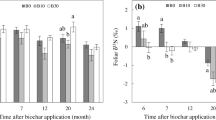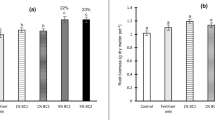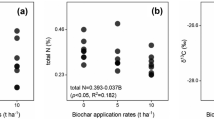Abstract
This study aimed to evaluate the improvement in soil fertility and plant nutrient use in a macadamia orchard following biochar application. The main objectives of this study were to assess the effects of poultry litter and green waste biochar applications on nitrogen (N) cycling using N isotope composition (δ15N) and nutrient availability in a soil-plant system at a macadamia orchard, 5 years following application. Biochar was applied at 10 t ha−1 dry weight but concentrated within a 3-m diameter zone when trees were planted in 2007. Soil and leaf samples were collected in 2012, and both soil and foliar N isotope composition (δ15N) and nutrient concentrations were assessed. Both soil and foliar δ15N increased significantly in the poultry litter biochar plots compared to the green waste biochar and control plots. A significant relationship was observed between soil and plant δ15N. There was no influence of either biochars on foliar total N concentrations or soil NH4 +-N and NO3 −-N, which suggested that biochar application did not pose any restriction for plant N uptake. Plant bioavailable phosphorus (P) was significantly higher in the poultry litter biochar treatment compared to the green waste biochar treatment and control. We hypothesised that the bioavailability of N and P content of poultry litter biochar may play an important role in increasing soil and plant δ15N and P concentrations. Biochar application affected soil-plant N cycling and there is potential to use soil and plant δ15N to investigate N cycling in a soil-biochar-tree crop system. The poultry litter biochar significantly increased soil fertility compared to the green waste biochar at 5 years following biochar application which makes the poultry litter a better feedstock to produce biochar compared to green waste for the tree crops.

Similar content being viewed by others
References
Alburquerque JA, Salazar P, Barrón V, Torrent J, del Campillo MC, Gallardo A, Villar R (2013) Enhanced wheat yield by biochar addition under different mineral fertilization levels. Agron Sustain Dev 33:475–484
Atkinson CJ, Fitzgerald JD, Hipps NA (2010) Potential mechanisms for achieving agricultural benefits from biochar application to temperate soils: a review. Plant Soil 337:1–18
Baronti S, Vaccari FP, Miglietta F, Calzolari C, Lugato E, Orlandini S, Pini R, Zulian C, Genesio L (2014) Impact of biochar application on plant water relations in Vitis vinifera (L.). Eur J Agron 53:38–44
Blumfield TJ, Xu Z, Mathers NJ, Saffigna PG (2004) Decomposition of nitrogen-15 labeled hoop pine harvest residues in subtropical Australia. Soil Sci Soc Am J 68:1751–1761
Campbell CR, Plank CO (1998) Preparation of plant tissue for laboratory analysis. Methods for Plant Analysis, p 37
Chan KY, Van Zwieten L, Meszaros I, Downie A, Joseph S (2007) Agronomic values of greenwaste biochar as a soil amendment. Soil Res 45:629–634
Clough TJ, Condron LM (2010) Biochar and the nitrogen cycle: introduction. J Environ Qual 39:1218–1223
Clough TJ, Condron LM, Kammann C, Müller C (2013) A review of biochar and soil nitrogen dynamics. Agronomy 3:275–293
Cui HJ, Wang MK, Fu ML (2011) Enhancing phosphorus availability in phosphorus-fertilized zones by reducing phosphate adsorbed on ferrihydrite using rice straw derived biochar. J Soils Sediments 11:1135–1141
de la Rosa JM, Knicker H (2011) Bioavailability of N released from N rich pyrogenic organic matter: an incubation study. Soil Biol Biochem 43:2368–2373
DeLuca TH, MacKenzie MD, Gundale MJ, Holben WE (2006) Wildfire-produced charcoal directly influences nitrogen cycling in ponderosa pine forests. Soil Sci Soc Am J 70:448–453
Dijkstra P, LaViolette CM, Coyle JS, Doucett RR, Schwartz E, Hart SC, Hungate BA (2008) 15N enrichment as an integrator of the effects of C and N on microbial metabolism and ecosystem function. Ecol Lett 11:389–397
Fiorentino G, Caracuta V, Casiello G, Longobardi F, Sacco A (2012) Studying ancient crop provenance: implications from δ13C and δ15N values of charred barley in a Middle Bronze Age silo at Ebla (NW Syria). Rapid Commun Mass Spec 26:327–335
Hogberg P (1997) Tansley review no. 95. 15N natural abundance in soil-plant systems. New Phytol 137:179–203
Hosseini Bai S, Sun F, Xu ZH, Blumfield TJ (2013) Ecophysiological status of different growth stage of understorey Acacia leiocalyx and A. disparimma in an Australian dry sclerophyll forest subjected to prescribed burning. J Soils Sediments 13:1378–1385
Hosseini Bai S, Blumfield T, Reverchon F (2014) The impact of mulch type on soil organic carbon and nitrogen pools in a sloping site. Biol Fertil Soils 50:37–44
Ibell PT, Xu ZH, Blumfield TJ (2012) The influence of weed control on foliar δ15N, δ13C and tree growth in an 8 year-old exotic pine plantation of subtropical Australia. Plant Soil 369:199–217
Joseph S, Camps-Arbestain M, Lin Y, Munroe P, Chia C, Hook J, Van Zwieten L, Kimber S, Cowie A, Singh B (2010) An investigation into the reactions of biochar in soil. Soil Res 48:501–515
Karkalas J (1985) An improved enzymic method for the determination of native and modified starch. J Sci Food Agric 36:1019–1027
Kleinebecker T, Hölzel N, Prati D, Schmitt B, Fischer M, Klaus VH (2013) Evidence from the real world: 15N natural abundances reveal enhanced nitrogen use at high plant diversity in Central European grasslands. J Ecol. doi:10.1111/1365-2745.12202
Kookana R, Sarmah A, Van Zwieten L, Krull E, Singh B (2011) Biochar application to soil: agronomic and environmental benefits and unintended C consequences. Adv Agron 112:103–143
Laird DA (2008) The charcoal vision: a win–win–win scenario for simultaneously producing bioenergy, permanently sequestering carbon, while improving soil and water quality. Agron J 100:178–181
Lal R (2004) Soil carbon sequestration impacts on global climate change and food security. Science 304:1623–1627
Lal R (2010) Beyond Copenhagen: mitigating climate change and achieving food security through soil carbon sequestration. Food Sec 2:169–177
Lobe I, Bol R, Ludwig B, Du Preez C, Amelung W (2005) Savanna-derived organic matter remaining in arable soils of the South African Highveld long-term mixed cropping: evidence from δ13C and δ15N natural abundance. Soil Biol Biochem 37:1898–1909
Macdonald L, Farrell M, van Zwieten L, Krull E (2014) Plant growth responses to biochar addition: an Australian soils perspective. Biol Fertil Soils 50:1035–1045
Major J, Rondon M, Molina D, Riha S, Lehmann J (2010) Maize yield and nutrition during 4 years after biochar application to a Colombian savanna oxisol. Plant Soil 333:117–128
Pérez T, Garcia-Montiel D, Trumbore S, Tyler S, Camargo P, Moreira M, Piccolo M, Cerri C (2006) Nitrous oxide nitrification and denitrification 15N enrichment factors from Amazon forest soils. Ecol Appl 16:2153–2167
Rayment G, Higginson FR (1992) Australian laboratory handbook of soil and water chemical methods. Inkata Press Pty Ltd, Melbourne
Reverchon F, Flicker RC, Yang H, Yan G, Xu Z, Chen C, Bai SH, Zhang D (2014a) Changes in δ15N in a soil–plant system under different biochar feedstocks and application rates. Biol Fertil Soils 50:275–283
Reverchon F, Yang H, Ho TY, Yan G, Wang J, Xu Z, Chen C, Zhang D (2014b). A preliminary assessment of the potential of using an acacia—biochar system for spent mine site rehabilitation. Env Sci Pollu Res 1–7. doi:10.1007/s11356-014-3451-1
Rui Y, Wang S, Xu Z, Wang Y, Chen C, Zhou X, Kang X, Lu S, Hu Y, Lin Q (2011) Warming and grazing affect soil labile carbon and nitrogen pools differently in an alpine meadow of the Qinghai–Tibet Plateau in China. J Soils Sediments 11:903–914
Singh BP, Hatton BJ, Singh B, Cowie AL, Kathuria A (2010) Influence of biochars on nitrous oxide emission and nitrogen leaching from two contrasting soils. J Environ Qual 39:1224–1235
Slavich PG, Sinclair K, Morris SH, Kimber SWL, Downie A, Van Zwieten L (2013) Contrasting effects of manure and green waste biochars on the properties of an acidic ferralsol and productivity of a subtropical pasture. Plant Soil 366:213–227
Taghizadeh-Toosi A, Clough TJ, Sherlock RR, Condron LM (2012) Biochar adsorbed ammonia is bioavailable. Plant Soil 350:57–69
Tilman D, Cassman KG, Matson PA, Naylor R, Polasky S (2002) Agricultural sustainability and intensive production practices. Nature 418:671–677
Tutua SS, Xu Z, Blumfield TJ (2014) Foliar and litter needle carbon and oxygen isotope compositions relate to tree growth of an exotic pine plantation under different residue management regimes in subtropical Australia. Plant Soil. doi:10.1007/s11104-013-1951-2
Van Zwieten L, Kimber S, Morris S, Chan K, Downie A, Rust J, Joseph S, Cowie A (2010a) Effects of biochar from slow pyrolysis of papermill waste on agronomic performance and soil fertility. Plant Soil 327:235–246
Van Zwieten L, Kimber S, Morris S, Downie A, Berger E, Rust J, Scheer C (2010b) Influence of biochars on flux of N2O and CO2 from ferrosol. Soil Res 48:555–568
Van Zwieten L, Kimber S, Downie A, Morris S, Rust J, Chan KY (2010c) A glasshouse study on the interaction of low mineral ash biochar with nitrogen in a sandy soil. Aust J Soil Res 48:569–576
Van Zwieten L, Kimber SW, Morris SG, Singh BP, Grace P, Scheer C, Rust J, Downie A, Cowie A (2013) Pyrolysing poultry litter reduces N2O and CO2 flux. Sci Total Environ 465:279–287
Wang T, Camps-Arbestain M, Hedley M, Bishop P (2012) Predicting phosphorus bioavailability from high-ash biochars. Plant Soil 357:173–187
Wang Y, Xu Z, Zhou Q (2014) Impact of fire on soil gross nitrogen transformations in forest ecosystems. J Soils Sediments 14:1030–1040
Weir KL, Wilson JR, White RJ (1977) CSIRO Aust Div Trop Past Tech 20:1–10
Xu Z, Saffigna P, Farquhar G, Simpson J, Haines R, Walker S, Osborne D, Guinto D (2000) Carbon isotope discrimination and oxygen isotope composition in clones of the F1 hybrid between slash pine and Caribbean pine in relation to tree growth, water-use efficiency and foliar nutrient concentration. Tree Physiol 20:1209–1217
Xu ZH, Ward S, Chen CR, Blumfield T, Prasolova N, Liu JX (2008) Soil carbon and nutrient pools, microbial properties and gross nitrogen transformations in adjacent natural forest and hoop pine plantations of subtropical Australia. J Soils Sediments 8:99–105
Xu ZH, Chen CR, He JZ, Liu JX (2009) Trends and challenges in soil research 2009: linking global climate change to local long-term forest productivity. J Soils Sediments 9:83–88
Yao FX, Arbestain MC, Virgel S, Blanco F, Arostegui J, Macia-Agullo JA, Macias F (2009) Simulated geochemical weathering of a mineral ash-rich biochar in a modified Soxhlet reactor. Chemosphere 80:724–732
Acknowledgments
The authors would like to acknowledge the technical support of Joshua Rust and Scott Petty from the New South Wales Department of Primary Industries and the owner of the farm Ms. Debbie Lewis. The establishment and maintenance of the field site was co-funded as part of an Australian Government Caring for our Country grant in collaboration with Mr Tony Walker from Richmond Landcare. We also acknowledge Mr. Geoffrey Lambert for his laboratory assistance and Mr. Rene Diocares for stable isotope analyses. This study was supported with Seed Funding from the University of the Sunshine Coast and Griffith University. SHB and CYX were research fellows supported by Collaborative Research Network – University of the Sunshine Coast Research Futures project.
Author information
Authors and Affiliations
Corresponding author
Additional information
Responsible editor: Philippe Garrigues
Electronic supplementary material
Below is the link to the electronic supplementary material.
Supplementary Tables 1
(DOCX 14 kb)
Supplementary Tables 2
(DOCX 14 kb)
Rights and permissions
About this article
Cite this article
Hosseini Bai, S., Xu, CY., Xu, Z. et al. Soil and foliar nutrient and nitrogen isotope composition (δ15N) at 5 years after poultry litter and green waste biochar amendment in a macadamia orchard. Environ Sci Pollut Res 22, 3803–3809 (2015). https://doi.org/10.1007/s11356-014-3649-2
Received:
Accepted:
Published:
Issue Date:
DOI: https://doi.org/10.1007/s11356-014-3649-2




